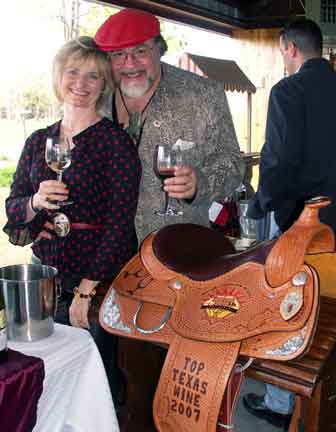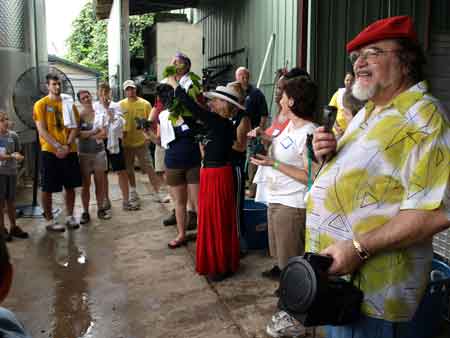Texas Ports of Call – Port, Food, and Chocolate Pairing Ideas from Messina Hof Winery & Resort

NOTE: A Vintage Texas blog reader recently posted a comment that requested information on pairing chocolate and wine. I responded that I believe that I could do this one better to include food, chocolate and wine pairing ideas, based on an event that I covered at Messina Hof Winery and Resort in Bryan, Texas. The following posting is based on my preparation and experiences from this event.
++++++++++++++++++++++++++++
You might be surprised to hear that Texas has been at the forefront of the national and international wine scene with its Port wine production? Winemakers like Paul Bonarrigo at Messina Hof have stirred the “fermentation tank” and added a healthy dose of innovation to Port-style winemaking that appears to be potentially perking demand for this sultry sweet drink.
I had the pleasure of visiting Messina Hof to experience something that piqued my culinary interest….Merrill Bonarrigo’s Port Wine and Chocolate Pairing Luncheon.
Actually, this event was a dual experience that combined a unique three-course, food encounter with winemaker Paul Bonarrigo’s educational, blending laboratory presentation. And all this took place in the beautiful setting of Messina Hof’s Vintage House restaurant on a delightfully warm, sunny day that made for a pleasant road trip to their winery in Bryan, Texas, about 80 miles northwest of Houston.
Ports and Other Sweet Fortified Wines
Port-style wines actually pre-date their namesake country, with thick, sweet wines being common in Greek and Roman times. As it turns out, the high sugar and alcohol contents of these wines act as preservatives and have been used particularly in warmer wine producing regions for this reason for millennia.
Once sweet, alcoholic wines were made, they were incredibly stable and could be transported great distances by ship or road, or stored for years waiting for just the right banquet accompaniment. In fact, to this day, most wine producing areas around the Mediterranean still have their own brand of sweet, fortified wine that is intertwined with local culture and cuisine. As has been shown previously, Texas has much in common (actually more than you might first realize) with many of these sunny winemaking locales.
It was the Portuguese that actually converted Port making into an artisanal craft. By the 13th century, wine producers in Portugal were exporting their wines from the Douro River valley. But, it was the demand for hearty red wines in Britain in the 17th century, combined with their king’s political disdain for all things French that fueled their fledgling Port making industry.
For centuries, this fortified wine has been made in the classic manner that stops the grape fermentation to maintain residual sugar and then brings the alcohol up to 18 to 20 percent through the addition of Brandy. Paul Bonarrigo has been on the forefront of Port-making by using a strain of yeast that can remain active up to these very high alcohol levels. This innovation allows him to make a “naturally” fermented Port without the dosage of Brandy.
The Main Event: Food – Chocolate – Port
The luncheon at Messina Hof was a great expression of winemaking and wine and food pairing, much in keeping with the characteristics of Paul and Merrill Bonarrigo who hosted this event at Messina Hof. I especially like wine and food experiences that take people and wine out of their conventional genre and context. Well, this one really filled the bill. It is not very often that a gourmet meal starts and finishes with port wine and, where every course includes chocolate. I expected that it would be even rarer to find people that might think that it could work, but there were many that spent their afternoon trying out this eclectic culinary handiwork.
The menu had countless flavor elements to tingle the palate and made it receptive to the full favored, Port-style wines from Messina Hof. As stated by Merrill Bonarrigo, “The menu and recipes were prepared with the complexity of the flavor components of the foods and wines in mind, and to show how they work singularly and together.”
Merrill continued by explaining her Port pairing tips, “First serve foods that have assertive flavor components, especially those that can stand up to the intensity of Port. Secondly, serve foods that are less sweet than Port. When the food is sweeter than the wine, it tends to make the wine taste sour. Finally, don’t forget that you can also substitute some Port for just about any sweet component in the preparation. This helps to bring the food and wine flavors together.”
First Course – Salad
The endive salad, served as the first course in combination with the Messina Hof Ivory Ports of Call (a White Port), was one of the best and unique amalgamations of the day. The salad was prepared with strong flavor elements coming from the pistachios, bitter chocolate, balsamic vinegar, raisins and black pepper. It may surprise some of you that Port can be white. It is far less common than hearty red Ports, but in this case, the wine consisted of a blend of strongly scented and highly floral Muscat Canelli and Sauvignon Blanc grapes that had received some aging in French oak.
During this first course, Paul Bonarrigo illustrated the role of acidity in wines by preparing a modified, high-acid version of his Ivory Port. As Paul pointed out, “Acidity is usually a good quality in wines which keeps them fresh and interesting on the palate. However, too much acidity can lead to a bitter sensation that can actually detract from the sweetness of the Port.”
In this case, the combination of sweetness and acidity in the Ivory Port helped to match the same qualities in the raisins and balsamic vinegar while also ameliorating and integrating the chocolate. The third noticeable aspect of the wine and food pairing was the oak aging that added structure to the wine while being a facilitator for the nuttiness of the pistachios and the pepper in the salad.
Second Course – Chicken Mole
The second course was a spicy chicken mole preparation that contained chocolate, onions, tomatoes, cumin and chipotle peppers served in combination with Messina Hof Tex-Zin (Red Zinfandel). This grouping combined a full-flavored white meat dish with a full-bodied red wine – Gee, did you know that you can do that?
Merrill’s strategy that worked well is summed up in her statement, “The wine should be dictated by the flavors and their intensity in the food, which can actually come from the sauce or spices.” In this case, the strong elements of tomato, spices and chocolate in the sauce melded fine with the wine’s underpinning of dark berries which was punctuated by smoky, peppery qualities that, in turn, were a superb match for these same characteristics brought by the chipotles.
Paul then demonstrated the impact of oak aging by comparing the Red Zinfandel to a modified version that had about twice the oak intensity (essentially “over-oaked”). It was obvious that the additional oak aging worked counter to the food-friendliness of the wine, thus illustrating another of Merrill’s wine and food pairing tips.
Third Course – Dessert
The final course was a chocolate adaptation of the quintessential dessert – Crème Brûlée, served with Messina Hof Papa Paulo Private Reserve Port along with a traditional Port (fortified with Brandy).
Crème Brûlée is already rich in crème and the addition of chocolate gave it an added weight and flavor intensity that begged for a substantial wine. A natural pairing for rich chocolate-infused desserts are sweet red wines that exude distinctive dark berry, cherry and chocolate qualities. The Papa Paulo Port held up its side of the pairing quite well. The vanilla aroma infused into the wine by 24 months of oak aging also joined up with the vanilla in the dessert, as well.
An interesting comparison was made between the naturally fermented Papa Paulo Port and the Brandy-fortified traditional Port. The absence of Brandy in the naturally fermented Port was most noticeable on the palate during the finish due to the improved smoothness sans the brandy addition. It was also a wonderful finish to an enlightening and educational afternoon at Messina Hof Winery and Resort.
Messina Hof Ports and Sherry
Messina Hof Winery now offers a range of fortified wines including five Ports and a Sherry. As explained by Merrill, “The Ports are the Ivory and Ebony Ports of Call, Barrel Reserve Port, Private Reserve Port, Paulo Port, and Tawny Port. The Sherry is called Solera. The Messina Hof Tawny Port was one of the saddle winners that Messina Hof received from the Houston Livestock Show and Rodeo.”

These ports are made from the Lenore (Black Spanish) grape that grows well all around Texas, but in totally different styles. It is amazing to taste the difference of the chocolate cherry in the ruby ports versus the cherry amaretto character of Tawny. For Paul to be able to make two such totally different wines from the same grape is truly amazing.
Merrill also related, “The Solera Sherry was a limited production available only locally. The first time one of our guests opened a bottle and tasted it they exclaimed, ‘It tastes like a liquid Cinnabon!’. I think it will be a perfect dessert wine for toasting the holidays.”
Paul and Merrill have now released there third cookbook called Vineyard Cuisine, Meals and Memories from Messina Hof. It has an entire section on wine and chocolate pairing. I had the feeling that it would since Merrill said in closing….”You know my love for chocolate!”
For more information on Messina Hof Winery and Resort, their winery B&B, and their complete offering of wines and upcoming events, go to: www.messinahof.com.

Hello. I think you could also make more of it through a bigger exposure about “Texas Ports of Call – Port, Food, and Chocolate Pairing Ideas”. Perhaps you can have some alcohol chocolates.
Now, that would be an interesting tasting. I have never looked into how many kinds of alcohol-filled chocolates I could find. How would be imaging the tasting notes might read?
Russ
CALVERT — Ken Wilkinson left his Memorial home to build a chocolate paradise in the little town of Calvert, two hours from Houston.
Called Cocoamoda, it features artisan bite-sized chocolates for $3 each and hot chocolate poured in Wedgwood china.
Cocoamoda is also a bistro. While other dining spots in Calvert sell hamburgers and chicken-fried steak, Cocoamoda offers brioche à tête with butter and apricot confiture, lobster bisque, escargot and rack of lamb.
Wilkinson expects his restaurant revenue to keep Cocoamoda afloat while the chocolate business grows. But chocolate is where his heart is. The London-born chef wants Cocoamoda to be the premier name in ultra-high-end chocolate: “That kind of thing you look at and say, ‘Yes, that’s Gucci, that’s Chanel, that’s Cocoamoda.’ ”
For more info, go to:
http://www.chron.com/disp/story.mpl/headline/biz/6101555.html